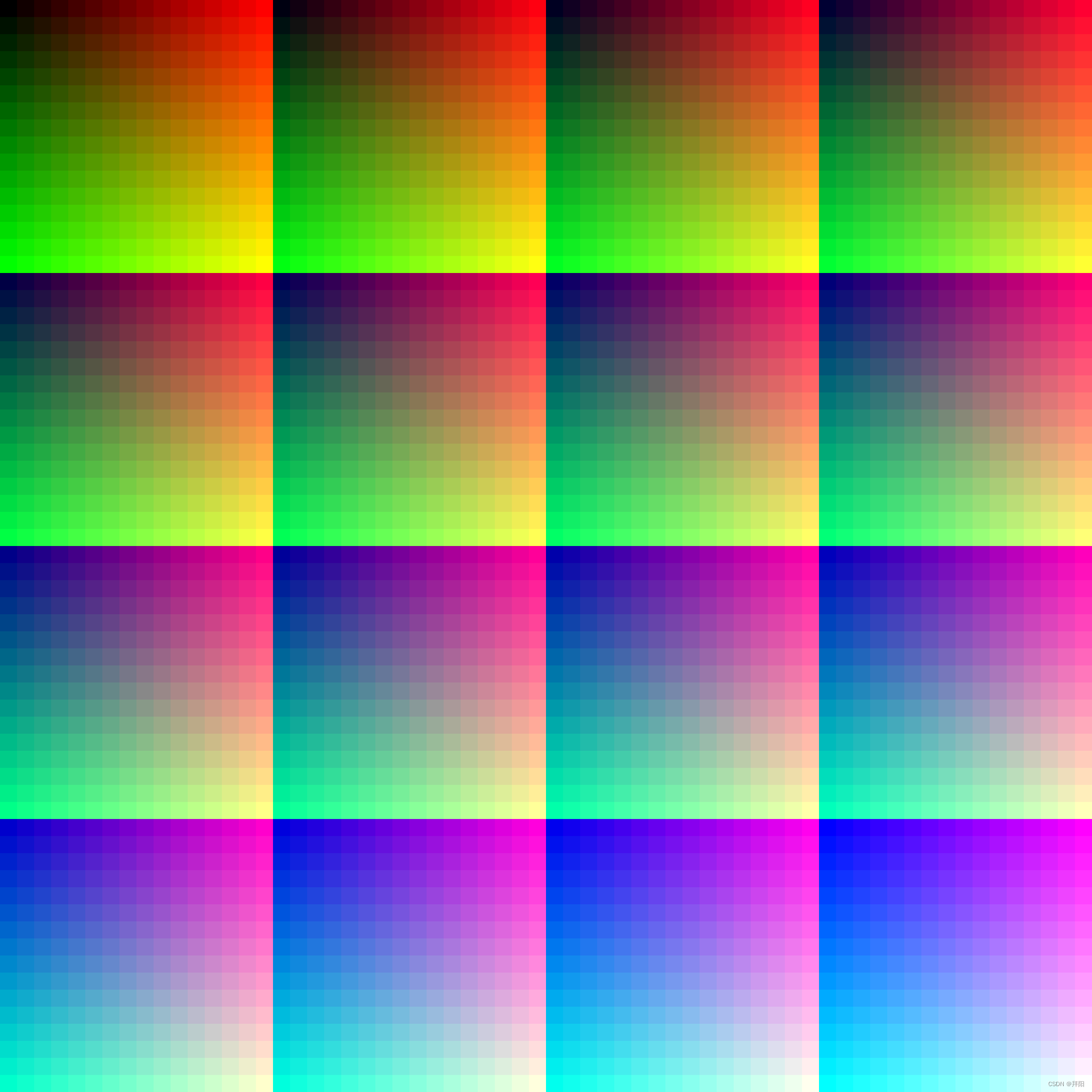Python 官方文档:入门教程 => 点击学习
目录前言格子颜色表渐变色带前言 在做色彩相关的算法分析时候,经常需要使用规则的颜色表来进行辅助。下面用python(numpy和OpenCV)来生成颜色表并保存为图片。 有两种类型:
在做色彩相关的算法分析时候,经常需要使用规则的颜色表来进行辅助。下面用python(numpy和OpenCV)来生成颜色表并保存为图片。
有两种类型:
长的样子分别如下:


这里需要注意,当划分的颜色数量比较少时,最好把一个颜色像素扩展成为一个格子,不然的话整个图看起来就太小了。
# -*- coding: utf-8 -*-
import cv2
import numpy as np
def generate_color_chart(block_num=18,
block_columns=6,
grid_width=32,
grid_height=None):
"""
Generate color chart by unifORMly distributed color indexes, only support
8 bit (uint8).
Parameters
----------
block_num: Block number of color chart, also the number of color indexes.
block_columns: Column number of color chart. Row number is computed by
block_num / block_columns
grid_width: Width of color grid
grid_height: Height of color grid. If not set, it will equal to grid_width.
"""
color_index = np.linspace(0, 255, block_num)
color_index = np.uint8(np.round(color_index))
if grid_height is None:
grid_height = grid_width
# compute sizes
block_rows = np.int_(np.ceil(block_num / block_columns))
block_width = grid_width * block_num
block_height = grid_height * block_num
width = block_width * block_columns
height = block_height * block_rows
result = np.zeros((height, width, 3), dtype=np.uint8)
# compute red-green block, (blue will be combined afterward)
red_block, green_block = np.meshgrid(color_index, color_index)
red_block = expand_pixel_to_grid(red_block, grid_width, grid_height)
green_block = expand_pixel_to_grid(green_block, grid_width, grid_height)
rg_block = np.concatenate([red_block, green_block], axis=2)
# combine blue channel
for i in range(block_num):
blue = np.ones_like(rg_block[..., 0], dtype=np.uint8) * color_index[i]
color_block = np.concatenate([rg_block, blue[..., np.newaxis]], axis=2)
# compute block index
block_row = i // block_columns
block_column = i % block_columns
xmin = block_column * block_width
ymin = block_row * block_height
xmax = xmin + block_width
ymax = ymin + block_height
result[ymin:ymax, xmin:xmax, :] = color_block
result = result[..., ::-1] # convert from rgb to bgr
return result
def expand_pixel_to_grid(matrix, grid_width, grid_height):
"""
Expand a pixel to a grid. Inside the grid, every pixel have the same value
as the source pixel.
Parameters
----------
matrix: 2D numpy array
grid_width: width of grid
grid_height: height of grid
"""
height, width = matrix.shape[:2]
new_heigt = height * grid_height
new_width = width * grid_width
repeat_num = grid_width * grid_height
matrix = np.expand_dims(matrix, axis=2).repeat(repeat_num, axis=2)
matrix = np.reshape(matrix, (height, width, grid_height, grid_width))
# put `height` and `grid_height` axes together;
# put `width` and `grid_width` axes together.
matrix = np.transpose(matrix, (0, 2, 1, 3))
matrix = np.reshape(matrix, (new_heigt, new_width, 1))
return matrix
if __name__ == '__main__':
color_chart16 = generate_color_chart(block_num=16,
grid_width=32,
block_columns=4)
color_chart18 = generate_color_chart(block_num=18,
grid_width=32,
block_columns=6)
color_chart36 = generate_color_chart(block_num=36,
grid_width=16,
block_columns=6)
color_chart52 = generate_color_chart(block_num=52,
grid_width=8,
block_columns=13)
color_chart256 = generate_color_chart(block_num=256,
grid_width=1,
block_columns=16)
cv2.imwrite('color_chart16.png', color_chart16)
cv2.imwrite('color_chart18.png', color_chart18)
cv2.imwrite('color_chart36.png', color_chart36)
cv2.imwrite('color_chart52.png', color_chart52)
cv2.imwrite('color_chart256.png', color_chart256)# -*- coding: utf-8 -*-
import cv2
import numpy as np
def generate_color_band(left_colors, right_colors, grade=256, height=32):
"""
Generate color bands by uniformly changing from left colors to right
colors. Note that there might be multiple bands.
Parameters
----------
left_colors: Left colors of the color bands.
right_colors: Right colors of the color bands.
grade: how many colors are contained in one color band.
height: height of one color band.
"""
# check and process color parameters, which should be 2D list
# after processing
if not isinstance(left_colors, (tuple, list)):
left_colors = [left_colors]
if not isinstance(right_colors, (tuple, list)):
right_colors = [right_colors]
if not isinstance(left_colors[0], (tuple, list)):
left_colors = [left_colors]
if not isinstance(right_colors[0], (tuple, list)):
right_colors = [right_colors]
# initialize channel, and all other colors should have the same channel
channel = len(left_colors[0])
band_num = len(left_colors)
result = []
for i in range(band_num):
left_color = left_colors[i]
right_color = right_colors[i]
if len(left_color) != channel or len(right_color) != channel:
raise ValueError("All colors should have same channel number")
color_band = np.linspace(left_color, right_color, grade)
color_band = np.expand_dims(color_band, axis=0)
color_band = np.repeat(color_band, repeats=height, axis=0)
color_band = np.clip(np.round(color_band), 0, 255).astype(np.uint8)
result.append(color_band)
result = np.concatenate(result, axis=0)
result = np.squeeze(result)
return result
if __name__ == '__main__':
black = [0, 0, 0]
white = [255, 255, 255]
red = [0, 0, 255]
green = [0, 255, 0]
blue = [255, 0, 0]
gray_band = generate_color_band([[0], [255]], [[255], [0]])
color_band8 = generate_color_band(
[black, white, red, green, blue, black, black, black],
[white, black, white, white, white, red, green, blue]
)
cv2.imwrite('gray_band.png', gray_band)
cv2.imwrite('color_band8.png', color_band8)到此这篇关于利用Python实现生成颜色表(color chart)的文章就介绍到这了,更多相关Python颜色表内容请搜索编程网以前的文章或继续浏览下面的相关文章希望大家以后多多支持编程网!
--结束END--
本文标题: 利用Python实现生成颜色表(colorchart)
本文链接: https://lsjlt.com/news/202118.html(转载时请注明来源链接)
有问题或投稿请发送至: 邮箱/279061341@qq.com QQ/279061341
2024-03-01
2024-03-01
2024-03-01
2024-02-29
2024-02-29
2024-02-29
2024-02-29
2024-02-29
2024-02-29
2024-02-29
回答
回答
回答
回答
回答
回答
回答
回答
回答
回答
0